
Overview
Our BioBricks were created to be used together to enable the polymerisation and functionalisation of biomaterials. All our composite parts contain our BioBrick 2.0 standardisation, which combines canonical BioBrick prefix and suffix with Golden Gate compatible BsaI sites. This standardisation allows for more efficient and flexible cloning.
To facilitate polymerisation and functionalisation, we created reporter devices flanked or capped by orthogonal inteins. These BioBricks contain SapI sites before and after their reporter sequence, to create plug-and-play systems where any material protein can be polymerised and any functionalising protein can be incorporated into the final biomaterial.
Ultimately, the idea of utilising spider silk to create water filtration biomaterials influenced the design and creation of our BioBricks.
BioBrick 2.0
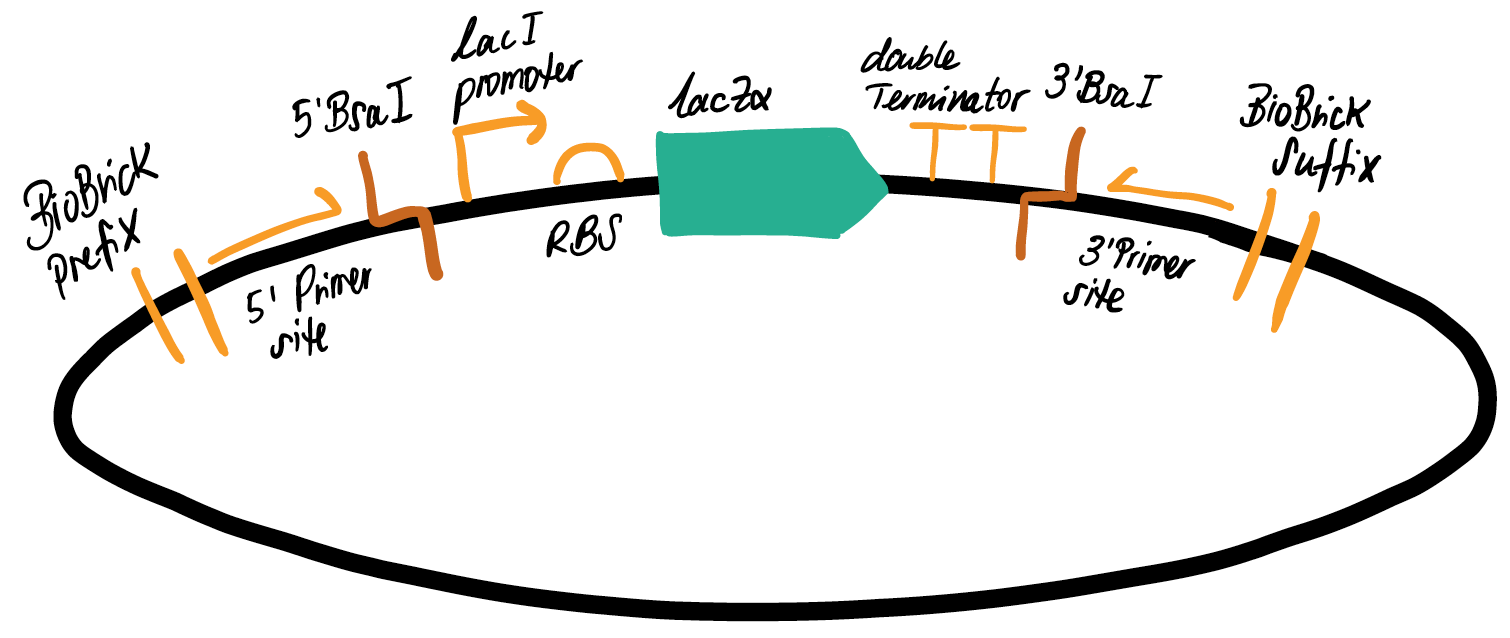
BBa_K2842666 is a BioBrick-compatible standard with improved flexibility that enables the integration of conventional cloning methods into iGEM’s workflow. Once inserted into a backbone, BioBrick2.0 allows cloning through Golden Gate assembly and Gibson assembly. At the same time, our construct has a LacZ reporter, which can be used to screen plates for successful colonies. BioBrick2.0 is a new standard, facilitating the cloning process for future iGEM teams.
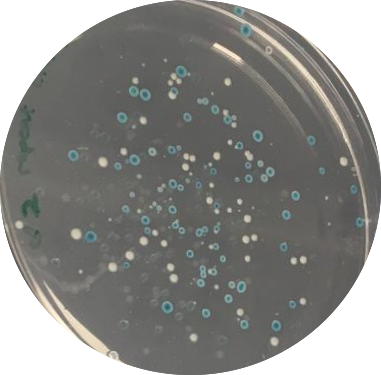
The lacZ reporter allows for blue-white screening. It can be displaced by compatible constructs through BioBrick assembly, Golden Gate or Gibson assembly. Blue-white screening is based on the inability of commercial E. coli to metabolise galactose or structurally similar substrates like X-Gal because of a lacZ deletion mutation. Once lacZα is provided through a plasmid, X-Gal can be metabolised to an easily detectable blue compound. This screening can also be used for subsequent cloning where the displacement of lacZ results in white colonies.
Intein Passenger (BBa_K2842669) was cloned into our BioBrick2.0 in pSB1C3 using BioBrick assembly and Golden Gate assembly. The same amount of ligation product was transformed into NEB competent E. coli DH5α (high efficiency) and plated onto LB Lennox L agar plates containing 20 μg/ml X-Gal. Ten- and hundred-fold dilutions were carried out to allow an accurate count of colony forming units. A comparison between the average number of blue and white colonies can be seen in the table below. The total number of colonies was similar for the two different cloning techniques. However, the ratio between white and blue colonies, indicating how successful cloning was, is higher for Golden Gate cloning. Therefore, our proposed BioBrick2.0 offers a valuable alternative to BioBrick assembly.
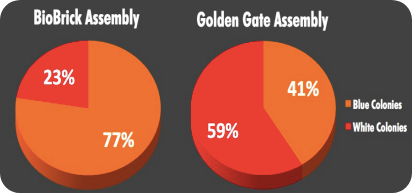
Intein Passenger
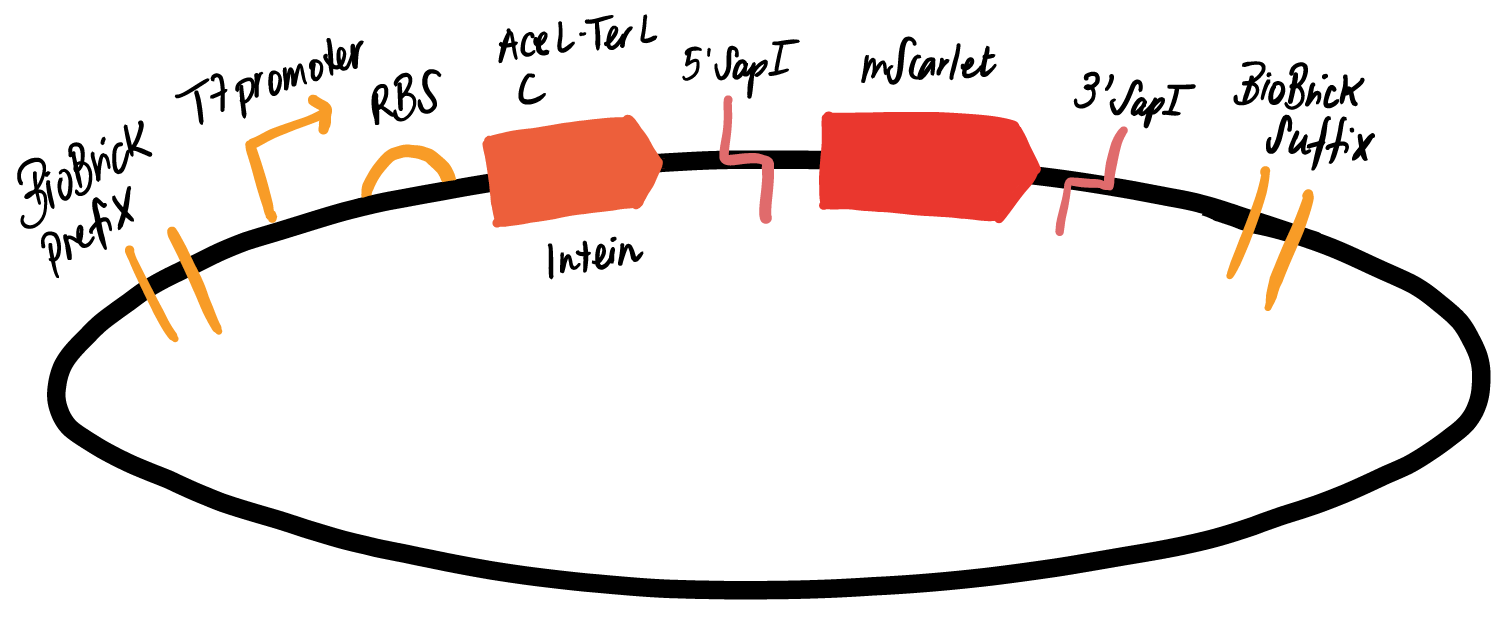
BBa_K2842669 is a DNA construct that encodes a C-terminal segment of the AceL-TerL intein fused to the N-terminus of a mScarlet reporter protein, which contains a C-terminal StrepTag for purification. The AceL-TerL intein acts as a protein ligase that forms a peptide bond between mScarlet and another protein bound to a complementary split intein. During this process, the intein splices itself out of the protein and is not present in the final fusion protein. This construct is a modular platform for the creation of split intein fusion proteins through the SapI restriction sites located immediately upstream and downstream of the mScarlet reporter. BBa_K2842680 was designed to be used in conjunction with this construct, as it contains the corresponding N-terminal intein segment to enable intein trans-splicing.
We expressed BBa_K2842669 in 50 mL cultures and extracted the intein fusion protein through sonication.
The clear lysate was purified on Strep-Tactin columns, and a following SDS-PAGE was performed on the samples (A). Additionally, the gel was visualised under UV (B).
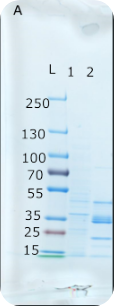

We cloned two different proteins of interest into our Intein Passenger BioBrick for the functionalisation of biomaterials. These functionalisations are documented in the section below.
Functionalisation
BBa_K2842710 utilises a NikR sequence, which encodes a small protein (133 amino acids) with high affinity (6.8 pM) to nickel. It is a two-domain protein and the C-terminal alone is sufficient to bind nickel tightly (2.2 pM). We used NikR as a proof of concept for our standardised intein fictionalisation method by assembling it in a modular fashion from BBa_K2842669. This construct could be used to functionalise intein polymers developed from BBa_K2842680 and BBa_K2842690 with the ability to bind and sequester nickel ions from solution.
BBa_K2842720 utilises an ER sequence, which encodes an ER protein member (M421F) from a superfamily of nuclear receptors. ER binds to its ligand, hormone 17β-estradiol, which activates a signaling pathway that regulates several key biological processes such as reproduction, embryonic development and homeostasis. When assembled with BBa_K2842669, this construct could be used to functionalise intein polymers developed from BBa_K2842680 and BBa_K2842690, with the ability to filter secreted estrogen-related hormones in solution.
Intein Monomer 1 (RFP)
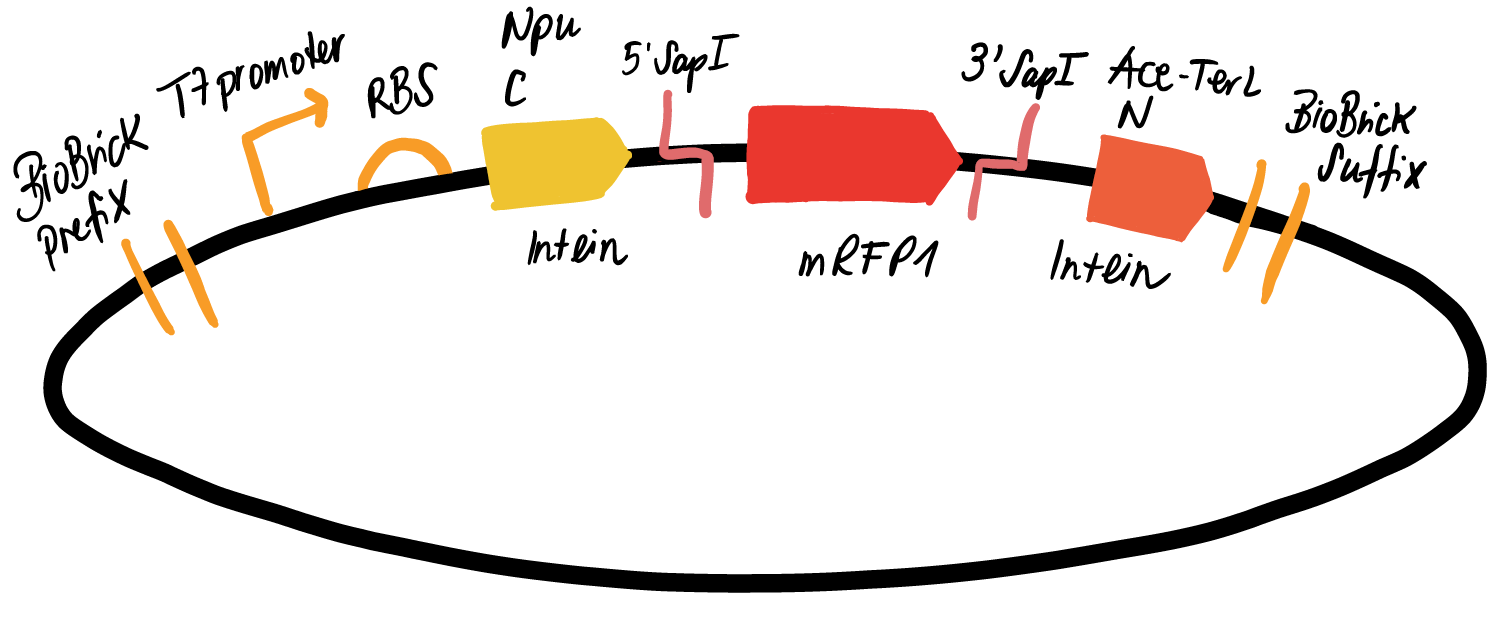
BBa_K2842680 is a genetic device that encodes a novel split-intein flanked reporter device, which enables the use of intein splicing for any protein of interest through SapI digestion. Intein Monomer 1 was created to work in conjunction with its complimentary composite part, Intein Monomer 2 (BBa_K2842690), to construct a intein polymerisation system.
We expressed BBa_K2842680 in 50 mL cultures and extracted the protein through sonication. The clear lysate was purified on Strep-Tactin columns, analysed by SDS-PAGE, and visualised under UV fluorescence.
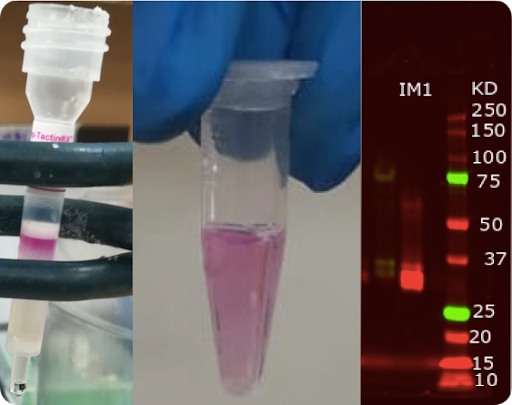
Intein Monomer 2 (GFP)
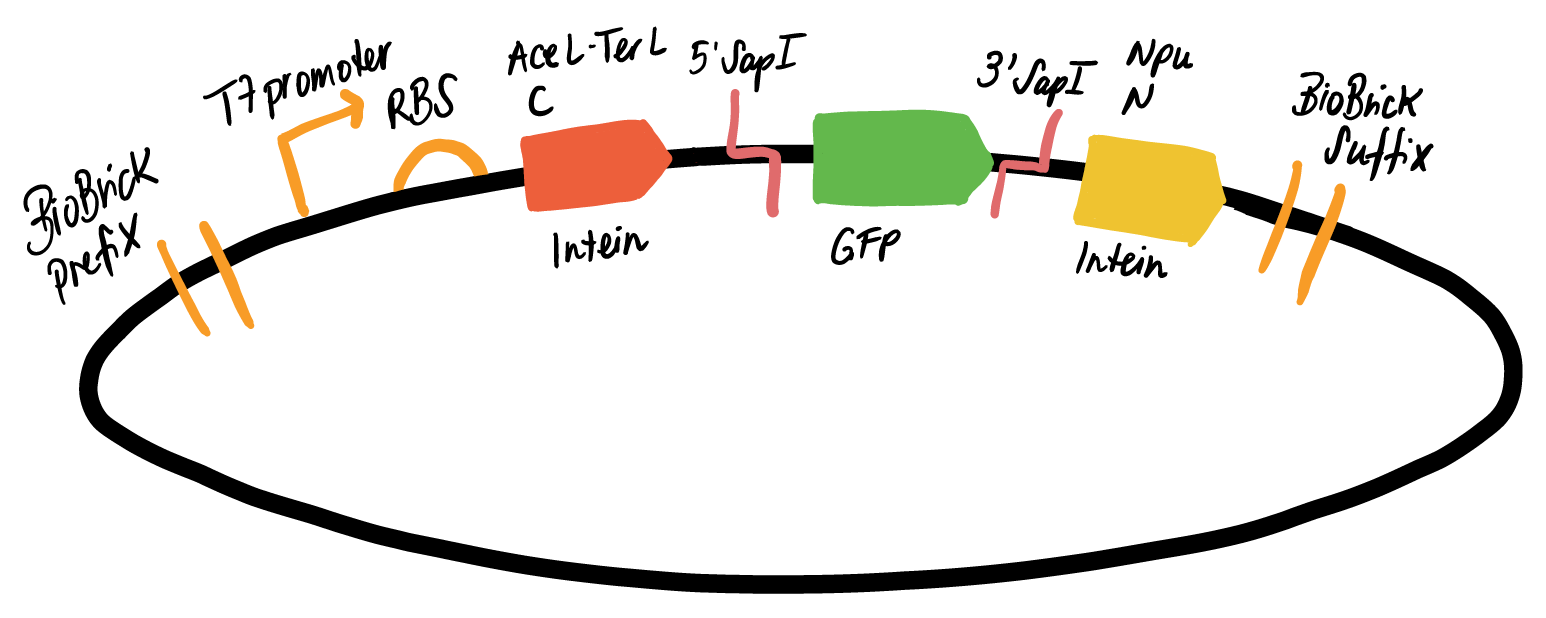
BBa_K2842690 is designed to work with Intein Monomer 1 (BBa_K2842680), as it is flanked with the corresponding split intein fragments for protein trans-splicing. A GFP reporter is flanked by the AcelTerL-C intein and the Npu-N intein, allowing for polymerisation by protein trans-splicing with other proteins flanked by two compatible split inteins. Like BBa_K2842680, it has SapI cassettes to facilitate the exchange of the sequences that are flanked by inteins. This enables the polymerisation of any protein that can be synthesised. Improper folding of the proteins impeded the functional expression of this construct.
Spider Silk
For the functionalisation of spider silk, we designed a construct to generate the fusion of a split intein (AceL-TerL N) and a synthetic spider silk protein (MaSp1). We chose to use a shortened synthetic spider-silk known as a “mini-spidroin” (35 kDa) as such proteins are easier to express compared to native length proteins (350 kDa). Mini-spidroins are still capable of being spun into fibres to produce biomaterials and are a promising model system for functionalisation. High GC content and potential sequencing issues, impeded the cloning of this construct, and hence prevented further spider silk workflow.
We intend on using our modular SapI assembly system, from BioBricks BBa_K2842680 and BBa_K2842690, to generate constructs that are capable of polymerising dragline spider silk proteins. Our modelling with LAMMPS and the literature suggest that longer length spider-silk proteins have improved mechanical properties. In addition to this, spider silk is a notoriously difficult protein to synthesise. Therefore, by breaking up the protein into shorter segments and assembling it post-translationally, the scale-up of the production of spider silk biomaterials can be enabled.
| BioBrick | Description | Length (bp) |
|---|---|---|
| BBa_K2842667 | Flexible Cloning Region F | 33 |
| BBa_K2842668 | Flexible Cloning Region R | 33 |
| BBa_K2842670 | Lac Operator | 17 |
| BBa_K2842671 | Ribosome binding site | 24 |
| BBa_K2842672 | AceL-TerL-C intein | 312 |
| BBa_K2842673 | Efficient Cleavage Site | 9 |
| BBa_K2842675 | SapI Cassette F | 15 |
| BBa_K2842676 | SapI Cassette R | 15 |
| BBa_K2842678 | Spidroin N-terminus | 402 |
| BBa_K2842679 | Efficient Cleavage site | 9 |
| BBa_K2842681 | mRFP1 | 675 |
| BBa_K2842682 | Npu-C intein | 108 |
| BBa_K2842683 | AceL-TerL-N intein | 75 |
| BBa_K2842684 | Ribosome Binding Site | 22 |
| BBa_K2842685 | Spacer | 20 |
| BBa_K2842691 | Npu-N intein | 312 |
| BBa_K2842692 | AceL-TerL-C intein | 312 |
| BBa_K2842693 | Efficient Cloning Site for Npu-C intein | 9 |
| BBa_K2842694 | Efficient Cloning Site for AceL-TerL-C intein | 9 |
| BBa_K2842695 | SapI cassete GFP F | 15 |
| BBa_K2842696 | SapI cassete GFP R | 15 |
| BBa_K2842697 | Spacer | 9 |
| BBa_K2842698 | RBS for GFP | 27 |
| BBa_K2842699 | GFP codon optimised | 714 |
| BBa_K2842704 | Ribosome binding site | 18 |
| BBa_K2842705 | Npu-C intein | 104 |
| BBa_K2842706 | Spidroin C-terminus | 363 |
| BBa_K2842707 | Spacer | 14 |
| BBa_K2842708 | SGS linker | 9 |
| BBa_K2842709 | NikR C-terminal domain (E. coli) | 255 |
| BBa_K2842711 | Estrogen receptor protein (M421F) | 744 |
| BBa_K2842666 | Golden Gate compatible system with blue-white screening (BioBrick 2.0) | 679 |
| BBa_K2842669 | mScarlet reporter with AceL-TerL-C intein on the N terminus (intein passenger) | 1256 |
| BBa_K2842680 | Intein Monomer 1: RFP reporter flanked with orthogonal inteins (RFP intein) | 1197 |
| BBa_K2842690 | Intein Monomer 2: GFP reporter flanked with orthogonal inteins (GFP intein) | 1568 |
| BBa_K2842700 | N-Terminus with AceL-TerL-N intein (minispidroin NT) | 597 |
| BBa_K2842701 | C-Terminus with Npu-C intein minispidroin CT) | 721 |
| BBa_K2842710 | NikR with AceL-TerL-C intein | 803 |
| BBa_K2842720 | Estrogen receptor protein (M421F) with TerL-C intein | 1304 |




